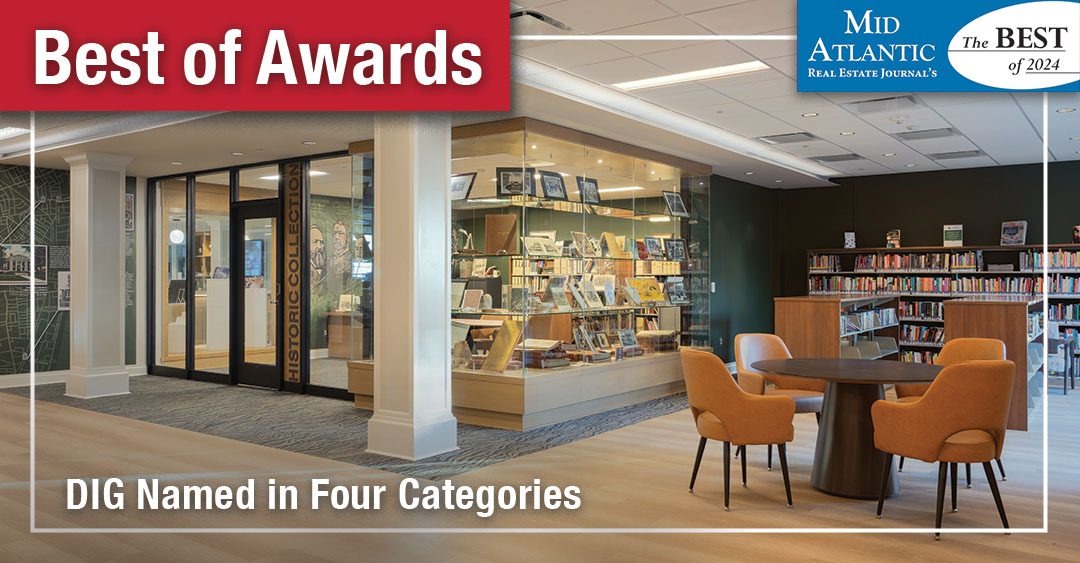Building upon its reputation for award-winning architecture, interior and environmental graphic design, DIGroup Architecture (DIG) has been named to the MidAtlantic Real Estate Journal’s annual “Best Of 2024” rankings in its March issue. This recognition highlights the company’s significant achievements in serving clients across the education, civic, healthcare and senior living sectors throughout the Mid-Atlantic Region during the past year.
The MidAtlantic Real Estate Journal’s “Best Of” awards celebrate the top properties/facilities, companies, best practices and projects across New Jersey, Pennsylvania, Delaware, Maryland, Virginia, and Washington D.C. DIG’s inclusion in this list underscores its commitment to excellence as well as impactful contributions to the region’s architectural landscape.
The firm earned top honors in the following categories:
Best of Architecture [Long Branch Free Public Library]
Type of Project: Size: 22,500 SF
“DIG’s transformation of the Long Branch Free Public Library showcases architectural ingenuity in revitalizing a historic landmark in the community. Through strategic architectural interventions, DIG modernized the space while maintaining its historic integrity through interior reconfigurations that improve daylighting, accessibility and functionality. Material selection and detailing were executed to honor the original Carnegie-era aesthetic while enhancing durability and sustainability. The firm re-envisioned the children’s library to offer a new teen library, complete with technology access for after-school services. Blending architectural preservation with purposeful modernization, this project reinforces DIG’s commitment to design spaces fostering connection, equity and long-term community impact,” according to the selection committee.
Best Historic Preservation [Long Branch Free Public Library]
Type of Project: Size 22,500 SF
The editorial team stated, “DIG’s Long Branch Free Public Library transformation was a rare opportunity to blend historic revitalization with modern innovation. This $5.5 million transformation revitalized a Carnegie-era landmark, restoring original architectural details while introducing a special collections room, dedicated young adult space and flexible community areas. Energy-efficient upgrades and a whole-building emergency generator ensure long-term sustainability. The project was both technically challenging and deeply impactful, preserving a vital community resource while equipping it with much-needed updates. This renovation will sustain the library as a cultural and educational anchor, honoring its past while preparing it for a vibrant future.”
In addition to its project acknowledgements, DIG was also recognized for its outstanding workplace culture. Here is what MAREJ had to say:
Best Places to Work: “Founded to combat inequality within education through the design and building of schools in underserved communities, DIG is a workplace where individuality is valued and celebrated, praised and recognized. As a matter of practice, the firm provides aspiring professionals – particularly women and people of color – with the necessary mentorship and tools to foster inclusiveness across architecture and all STEM-related careers. Recognizing underrepresentation limits creativity within the built environment, DIG’s business practices are purposefully developed to connect people, improve lives and enrich and strengthen communities – all while creating building blocks through community-based mentorship, licensure development, career experience and networking.”
Best of Giving Back: “DIG’s commitment to social impact extends well beyond its design work to community outreach initiatives and mentorship. This includes spearheading, participating in and sponsoring programming that harnesses its expertise to create positive societal change through its “Architecture for Change” mission. Examples include getting in front of minority young people through the Architecture, Construction and Engineering (ACE) Mentor Program; guest speaking engagements at local schools and colleges/universities; serving as panelists to discuss diversity in architecture; participating in STEM and construction-related events; and outreach within the communities in which DIG projects are located.”

